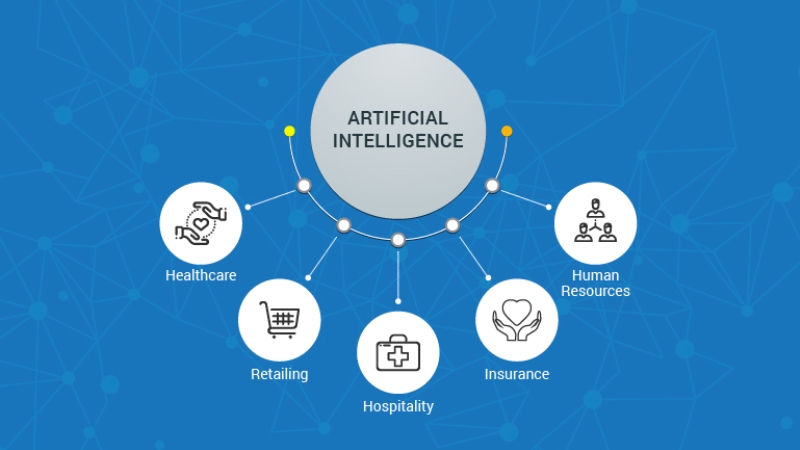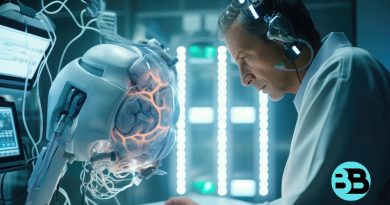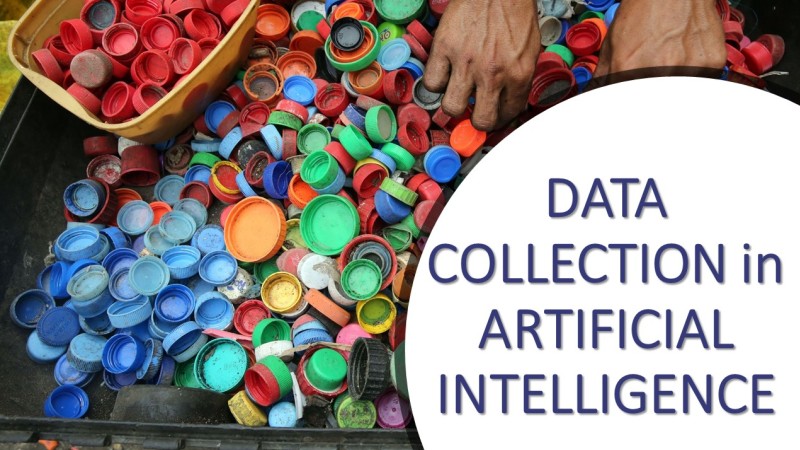How is AI transforming various industries such as healthcare, finance, and transportation?
Artificial Intelligence (AI) is transforming the way businesses operate across various industries. The healthcare, finance, and transportation sectors, in particular, have experienced significant changes due to the adoption of AI technologies. In this article, we will explore how AI is transforming these industries, the benefits and challenges of AI adoption, and the future of AI in these sectors.
Healthcare
AI has the potential to revolutionize the healthcare industry by providing personalized treatments, improving diagnosis accuracy, and streamlining administrative tasks. One of the main advantages of AI in healthcare is its ability to analyze vast amounts of patient data and identify patterns that can help physicians make better decisions. For instance, AI can analyze genetic data to identify the likelihood of a patient developing a particular disease. It can also help identify patients who are at risk of developing complications and recommend preventive measures.
AI is also being used in medical imaging analysis. Radiologists can use AI-powered tools to analyze images, detect abnormalities, and make more accurate diagnoses. For instance, AI can detect subtle changes in mammograms that might be difficult for radiologists to identify. AI is also being used to identify tumors in MRIs, CT scans, and X-rays.
AI is also being used in drug discovery. Pharmaceutical companies are using AI to analyze vast amounts of data to identify potential drug targets and compounds.
AI can help accelerate the drug discovery process by reducing the time and cost involved in traditional drug discovery methods.
AI is also being used in clinical trial research. Clinical trials require large amounts of data to be collected and analyzed. AI can help automate data collection and analysis, making the process more efficient and accurate. AI can also help identify potential patients for clinical trials and predict the likelihood of success for a particular drug.
Overall, the adoption of AI in healthcare can improve patient outcomes, reduce healthcare costs, and improve efficiency. However, there are also challenges to AI adoption in healthcare, such as privacy concerns, data security, and the need for regulation and standardization. The future of AI in healthcare is bright, and we can expect to see even more transformative changes in the coming years.
Finance
The finance industry has also experienced significant changes due to the adoption of AI. AI is transforming the way financial institutions operate by automating mundane tasks, detecting fraud, and improving customer experience.
One of the primary benefits of AI in finance is its ability to automate repetitive and time-consuming tasks. For instance, AI-powered chatbots can provide 24/7 customer service, reducing the need for human agents. This can improve customer experience by providing quick and accurate responses to queries.
AI is also being used to analyze customer data and provide personalized investment recommendations. Machine learning algorithms can analyze customer data to identify investment opportunities that align with their financial goals and risk tolerance. This can help financial institutions improve customer engagement and increase revenue.
AI is also being used to detect fraudulent transactions. Financial institutions are using AI to monitor transactions in real-time, detect anomalies, and block fraudulent transactions. This can help prevent financial losses and improve security.
The adoption of AI in finance also poses some challenges, such as ethical concerns, bias, and the need for transparency. There is also a need for regulation and standardization to ensure that AI is used ethically and responsibly. The future of AI in finance is promising, and we can expect to see even more transformative changes in the coming years.
Transportation
The transportation industry is also experiencing significant changes due to the adoption of AI. AI is transforming the way transportation systems operate by optimizing routes, reducing costs, and improving safety.
One of the primary benefits of AI in transportation is its ability to optimize routes. AI-powered systems can analyze traffic data in real-time and identify the most efficient routes for vehicles. This can help reduce travel time, fuel consumption, and emissions.
AI is also being used to improve safety.
AI is also being used to improve safety in transportation. Self-driving cars are a prominent example of AI in transportation. These cars use AI to detect and respond to road conditions, identify obstacles and pedestrians, and make decisions about acceleration, braking, and steering. Self-driving cars have the potential to reduce accidents caused by human error, reduce traffic congestion, and improve mobility for people with disabilities.
AI is also being used in predictive maintenance systems. These systems use AI to identify and repair issues before they cause disruptions. By detecting problems before they cause breakdowns, transportation companies can reduce downtime, save costs, and improve customer experience.
AI is also being used to optimize public transportation systems. AI-powered systems can analyze data on passenger demand, traffic patterns, and other factors to optimize routes, reduce congestion, and improve overall efficiency.
The adoption of AI in transportation also poses some challenges, such as cybersecurity, privacy concerns, and the need for regulations and policies. There are also ethical concerns around the use of self-driving cars and the impact on employment in the transportation industry. However, the potential benefits of AI in transportation are significant, and we can expect to see even more transformative changes in the coming years.
Challenges of AI Adoption
While the adoption of AI has significant benefits, it also poses several challenges. One of the main challenges is the lack of transparency and interpretability of AI systems. AI systems can be complex, making it difficult to understand how they work and how they make decisions. This can lead to distrust and skepticism among users.
Another challenge is bias in AI systems. AI systems can be biased if they are trained on biased data. For instance, if a hiring algorithm is trained on data that favors male candidates, it may discriminate against female candidates. Bias in AI can perpetuate existing inequalities and discrimination.
Privacy and security are also significant challenges in AI adoption. AI systems require vast amounts of data to be collected and analyzed. This data can include sensitive information such as medical records, financial information, and personal information. Ensuring the security and privacy of this data is crucial to prevent data breaches and other security incidents.
Regulation and standardization are also necessary to ensure that AI is used ethically and responsibly. There is a need for regulations and policies that ensure the transparency, accountability, and fairness of AI systems. Standardization is also necessary to ensure interoperability and compatibility among different AI systems.
Future of AI in Healthcare, Finance, and Transportation
The future of AI in healthcare, finance, and transportation is promising. In healthcare, AI has the potential to improve patient outcomes, reduce healthcare costs, and improve efficiency. We can expect to see continued adoption of AI in medical imaging analysis, drug discovery, and clinical trial research.
In finance, we can expect to see continued adoption of AI in automating mundane tasks, detecting fraud, and improving customer experience. We can also expect to see increased use of AI in risk management and investment management.
In transportation, we can expect to see continued adoption of AI in optimizing routes, reducing costs, and improving safety. We can also expect to see increased use of AI in mobility services such as ride-sharing and public transportation.
Conclusion
In conclusion, AI is transforming the healthcare, finance, and transportation industries by providing new opportunities to improve efficiency, accuracy, and effectiveness. The adoption of AI in these industries has significant benefits, but it also poses challenges such as privacy, bias, and the need for regulation and standardization. The future of AI in these industries is promising, and we can expect to see even more transformative changes in the coming years.
Retail: AI is being used in the retail industry to personalize customer experiences, optimize inventory management, and automate mundane tasks. Retailers are using AI-powered chatbots to provide customer service, AI-powered visual search to help customers find products, and AI-powered recommendations to suggest products based on customer preferences.
Manufacturing: AI is being used in the manufacturing industry to improve efficiency, reduce downtime, and optimize production processes. Manufacturers are using AI-powered predictive maintenance to identify potential issues before they cause downtime, AI-powered quality control to ensure product quality, and AI-powered supply chain optimization to improve efficiency.
Education: AI is being used in the education industry to personalize learning experiences, improve student outcomes, and automate administrative tasks. Educators are using AI-powered adaptive learning platforms to personalize instruction based on student performance, AI-powered grading tools to automate grading, and AI-powered chatbots to provide student support.
Agriculture: AI is being used in the agriculture industry to improve crop yields, reduce waste, and optimize resource management. Farmers are using AI-powered precision agriculture to analyze data on soil quality, weather patterns, and other factors to optimize crop growth, reduce waste, and improve resource management.
Energy: AI is being used in the energy industry to optimize production, improve safety, and reduce costs. Energy companies are using AI-powered predictive maintenance to identify potential issues before they cause downtime, AI-powered safety systems to detect and respond to safety hazards, and AI-powered energy management systems to optimize energy production and consumption.
As AI technology continues to advance, we can expect to see even more transformative changes in a wide range of industries. However, it is important to address the challenges of AI adoption and ensure that AI is used ethically and responsibly to achieve the greatest benefits for society.
Another significant way that AI is transforming various industries is through the creation of new business models and opportunities. For example, AI-powered platforms are being used to disrupt traditional business models and create new marketplaces.
One example of this is the sharing economy, which has been enabled by the rise of AI-powered platforms. Platforms such as Airbnb and Uber have disrupted traditional industries such as hospitality and transportation by providing alternative ways for people to access goods and services. These platforms use AI to match supply and demand, manage transactions, and personalize customer experiences.
Another example is the rise of AI-powered fintech startups that are using AI to disrupt traditional financial services. These startups are using AI to automate lending decisions, detect fraud, and personalize customer experiences. They are also using AI to provide financial services to underserved populations who may not have had access to traditional financial services.
In addition to creating new business models, AI is also enabling new forms of innovation. For example, AI is being used to create new products and services that were not possible before. These innovations are often the result of combining AI with other technologies such as robotics, blockchain, and the Internet of Things (IoT).
One example of this is the use of AI in robotics to create autonomous systems that can perform tasks that were previously impossible. For example, AI-powered robots are being used in manufacturing to assemble complex products such as airplanes and cars. These robots use AI to detect and respond to changes in the environment and adjust their behavior accordingly.
Another example is the use of AI in the IoT to create smart devices that can communicate with each other and with humans. These devices use AI to learn from user behavior, predict user preferences, and automate tasks. For example, a smart home system might use AI to learn when a user typically arrives home and adjust the temperature and lighting accordingly.
Overall, the transformative power of AI is not limited to specific industries or applications. AI has the potential to transform almost every aspect of our lives, from the way we work and communicate to the way we access goods and services. While there are certainly challenges and risks associated with AI adoption, the potential benefits are enormous, and we are only beginning to scratch the surface of what is possible.




